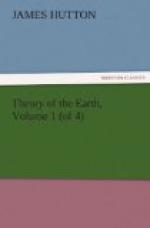In taking this view of things, where ends and means are made the object of attention, we may hope to find a principle upon which the comparative importance of parts in the system of nature may be estimated, and also a rule for selecting the object of our inquiries. Under this direction, science may find a fit subject of investigation in every particular, whether of form, quality, or active power, that presents itself in this system of motion and of life; and which, without a proper attention to this character of the system, might appear anomalous and incomprehensible.
It is not only by seeing those general operations of the globe which depend upon its peculiar construction as a machine, but also by perceiving how far the particulars, in the construction of that machine, depend upon the general operations of the globe, that we are enabled to understand the constitution of this earth as a thing formed by design. We shall thus also be led to acknowledge an order, not unworthy of Divine wisdom, in a subject which, in another view, has appeared as the work of chance, or as absolute disorder and confusion.
To acquire a general or comprehensive view of this mechanism of the globe, by which it is adapted to the purpose of being a habitable world, it is necessary to distinguish three different bodies which compose the whole. These are, a solid body of earth, an aqueous body of sea, and an elastic fluid of air.
It is the proper shape and disposition of these three bodies that form this globe into a habitable world; and it is the manner in which these constituent bodies are adjusted to each other, and the laws of action by which they are maintained in their proper qualities and respective departments, that form the Theory of the machine which we are now to examine.
Let us begin with some general sketch of the particulars now mentioned.
1st, There is a central body in the globe. This body supports those parts which come to be more immediately exposed to our view, or which may be examined by our sense and observation. This first part is commonly supposed to be solid and inert; but such a conclusion is only mere conjecture; and we shall afterwards find occasion, perhaps, to form another judgment in relation to this subject, after we have examined strictly, upon scientific principles, what appears upon the surface, and have formed conclusions concerning that which must have been transacted in some more central part.
2dly, We find a fluid body of water. This, by gravitation, is reduced to a spherical form, and by the centrifugal force of the earth’s rotation, is become oblate. The purpose of this fluid body is essential in the constitution of the world; for, besides affording the means of life and motion to a multifarious race of animals, it is the source of growth and circulation to the organized bodies of this earth, in being the receptacle of the rivers, and the fountain of our vapours.




